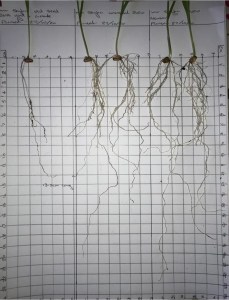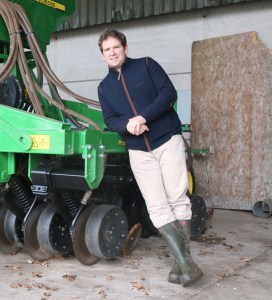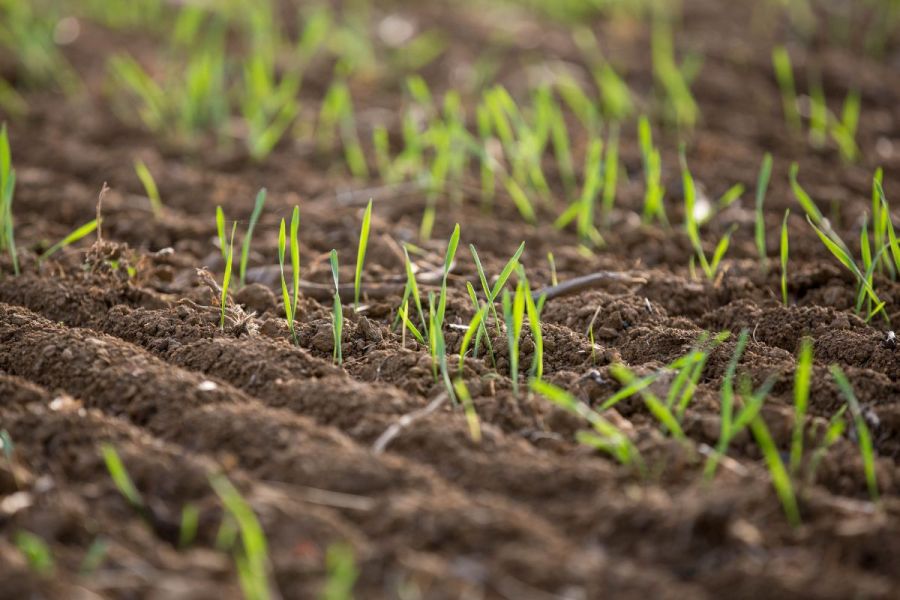As growers firm up crop management plans for the 2023 season, could biologicals and biostimulants find themselves becoming a more frequent part of production? CPM explores the concept.
“We’ve seen a huge difference.”
By Charlotte Cunningham
The beginning of a new year often marks an apt time to reflect on the 12 months passed and make plans for those that lie ahead as progress towards harvest 2023 steams ahead.
This might mean looking at how to tackle weeds and disease after a mild, wet winter, how nutrient management could be tweaked after the winter or even how biologicals and biostimulants could play a role ahead of the 2023 harvest.

Early applications of products like Bridgeway have been proven in trials to massively increase root mass which helps crops better cope under stress situations, like drought, says Stuart Sutherland.
Looking at the challenges growers face, a recent CPM/Interagro survey growers revealed the top factors limiting the ability of crops to yield to their full potential are lack of rain at the right time (52%), followed by loss of active ingredients due to regulatory policy and lack of sunshine at the right time – which each received 28% of the vote.
While these factors are out of the control of growers, there are measures that can be taken to help put soils and crops in a better place to cope with some of the challenges.
West Midlands farm manager and CPM’s 2022 Climate Change Champion, Michael Kavanagh, concurs with this and says the lack of active ingredients available was in fact the trigger point for his journey towards a more regenerative way of farming. “I was very aware that in my farming lifetime we were probably going to lose access to a lot of chemicals, so I started thinking about how we could farm without fungicides.”
Eight years on, and he’s now in a place where no insecticides are used and no bagged P and K – though soil indices are still improving – as well as no lime and only using fungicides once over the eight years. Getting to this point has involved incorporating a number of techniques, including moving to min and then no-till crop establishment and using alternative tools like biologicals and biostimulants.
“I started using biology about five years ago and, like everyone else, I was a bit unsure – did it really work or was it just witchcraft?” remembers Michael. “So I trialled it first on my wheat, with the aim of better priming the plant against disease pressures, and it really worked. It made me lift my head and realise there was something in this, but it’s very much part of the jigsaw rather than a silver bullet.”
Stuart Sutherland, technical manager at Interagro, picks up the conversation and explains that tools such as biologicals and biostimulants can help crops get off to a better start and protect themselves from stress situations. “We can’t do much about the weather, but early applications of products like Bridgeway have been proven in trials to increase root mass. If you’re improving root biomass early on, then the crop has better access to moisture and nutrition, so it’s possible that this can help to better prepare the plants ahead of any stress periods, such as drought and disease pressures.”
And these benefits have been seen in the field too, with 55% of growers stating they’ve found biologicals and/or biostimulants to be beneficial in improving root and shoot growth and 50% said they can improve the plant’s own natural defences against disease infection. A further 49% said they’ve found biological products to improve nutrient use efficiency (NUE), while 29% revealed that they’ve seen a benefit when it comes to protecting crops from drought stress.

Simon Bayliss has seen vast improvements to root size and structure through trials using peptide-based seed treatment, Newton.
Staffordshire farmer, Simon Bayliss is now into the ninth year of his regenerative farming journey and is focused on building resilience into his soil in order to grow better crops that are more prepared to withstand the challenges that come with modern day food production. This year the farm has gone completely biological. “We’re using a dose of biostimulants every time we go through the crop to increase the strength of the plant,” he explains.
The challenge with using products like biostimulants and biologicals is justifying the return on investment, but Simon believes that the visual benefits are clear. “We can see that the crops stay so healthy and with them being healthier, we don’t see stress and they stay green.”
But it’s not just environmental and climate conditions putting pressure on crop performance – high input prices seen over the past season have also caused many to rethink their crop nutrient management decisions.
Almost half (49%) of growers said they’re already tackling this by using more organic manures, while 46% stated that they are making use of biologicals and/or biostimulants to optimise uptake and use of what they do apply to the crop, with many saying they’ve already used seed treatments this past autumn to speed up establishment, optimise nutrition close to the seed and maximise soil biology, to name just a few reasons.
“A seed treatment is the earliest point at which you can use a biostimulant so by using one, you’re ensuring the crop gets off to a good start,” explains Stuart. “There’s trials evidence to show our product, Newton, can speed up germination in the lab and evidence in the field of faster emergence, as well as improved root and shoot biomass.”
Newton is a peptide-based biostimulant seed treatment which can be used on both conventional and organic crops and is designed to promote increased seed health at the point of drilling. “The signalling peptides within Newton play a fundamental role in the regulation of crop growth and development, which in turn leads to faster germination and emergence,” explains Stuart. “What’s more, these peptides also have a role to play in helping crops cope better under stress situations.”
Simon has seen first-hand the benefit of seed treatments and has had what he says are ‘excellent’ results since incorporating Newton into his system.

Simon Bayliss conducted tramline trials to find the best seed treatment, with Newton coming out on top. (left to right Beret plus Latitude Gold, naked seed, Newton).
The change in practice stemmed from his desire to move away from chemical dressings in his home-saved seed system, so he set up a three-way tramline trial comparing untreated seed, seed treated with Beret Gold (fludioxonil) plus Latitude (silthiofam) and finally Newton-treated seed. “We’ve seen a huge difference,” says Simon, who noted a considerable improvement in both size and structure of roots where Newton was used. “We don’t use anything else on seed now – no chemical dressings – and we think it’s far better. Once you get the seed off to a good start, the better it’s going to be throughout the rest of the season and we have shown this by using Newton.”
Looking ahead to crop management plans for 2023 in light of higher input prices, 52% of growers said they’ll be growing varieties which lend themselves to reduced fungicide inputs, while 37% said they’re planning to reduce ag-chem inputs where they can and use biologicals and biostimulants to improve soil and plant health.
Where inputs such as nitrogen fertiliser are used, ensuring application, uptake, utilisation and partitioning into grain is efficient is key. And with NUE a hot topic last year, work was carried out by Interagro in 2022 to test if there was a relationship between NUE and amino acid biostimulant usage.
This involved analysing the effect of different levels of nitrogen inputs to wheat treated with Bridgeway at GS12-14, explains Stuart. “This showed that we were able to increase the level of nitrogen in the leaf with an application of Bridgeway in situations of 100% nitrogen, 60% nitrogen and 30% nitrogen – with 100% nitrogen being equivalent to 80kg/ha. Having more nitrogen in the leaf is just one of the ways we thought we could prove better efficiency when Bridgeway is used. So if you are in a position where you have to reduce nitrogen, this might be one of the ways you can minimise the impact of that.”
Looking to foliar biologicals and biostimulants, 68% of growers said they plan to apply one of these types of product to their wheat area this spring/summer, while 20% are using the products on potatoes and other non-cereals such as spring beans and sugar beet.
For 56% of growers, the main reason for doing this is to help the crop access nutrition and increase assimilation, while 50% said they’re aiming to increase root and shoot growth. Over a third (37%) said they’re turning to biologicals and/or biostimulants to increase the plants defences to disease, and in turn hopefully reduce fungicide inputs, and a further 37% to optimise photosynthesis and the metabolic efficiency of the plant.

Drought is a particular problem on Michael Kavanagh’s light soils, but he says using biostimulants is proving to help keep crops healthier for longer.
Michael says he’s had success with using two of Interagro’s foliar-applied biostimulants – Bridgeway and Zodiac. “We seem to be going into a pattern of more drought-prone springs, and on some of our light soils around here, it really is a problem – it can be our biggest inhibitor of yield. So anything I can do to help that plant cope with that stress – such Bridgeway – is really beneficial. As part of the jigsaw, it’s a really crucial element in keeping crops healthy for us.”
With an eye on the likely high cost of growing crops this year, Simon says in his experience, taking a biological approach has economic benefits too. “It costs a lot less to do it this way – we haven’t dropped in yield, either. Last year we used a total of 120kgN/ha in wheat and that was it.”
Though according to the experts, the benefits of biologicals and biostimulants are clear, there are still some who see such products as ‘muck and magic’. Over half of growers said their biggest barrier to using more of these types of products is the need for more trials, while 17% said there’s too much choice on the market and knowing where to start can be a challenge.
“When it comes to the Interagro products, there’s a whole host of trial datasets,” says Stuart. “So, I’d encourage anyone to take a look at that to get more information about our range of biostimulants. Agronomists and manufacturers themselves are also a good source of information.
“If you’re still not sure where to start, data is always a good place. See who has done the work over multiple years on different varieties and various crops to get the confidence to go for it. There’s a lot of products out there, but some may not have large datasets behind them.”
Simon also recommends growers set up trials on their own farm to test whether or not biostimulants are something that can work for them.
Michael agrees: “Anything in place on this farm now is all because I’ve trialled it myself. There’s no point reading something in a book or a magazine and hoping for the same results. Every farm and every system is unique, so it’s really important to get out there and trial these things yourself to find what works for you.”
Winner announcement
Congratulations to our winner Matthew Houldcroft from Lincolnshire who responded to the CPM/Interagro survey on biostimulant usage and has won the fabulous prize of his choice, either an Apple iPhone 14, worth £849 OR an Apple iPad Pro, worth £899.
Matthew responded to the survey and completed the tie-breaker question, which asked respondents to detail, in their opinion, what the best use of biostimulants is.
His answer was: “Where the benefits are clear to see that the future of crop production needs to be from a kill and defend nature to feed and nurture the natural biosphere already in the soil,” which impressed the judges.
To take part in the next survey, make sure we have the correct details for you by emailing angus@cpm-magazine.co.uk
This article was taken from the latest issue of CPM. For more articles like this, subscribe here.




